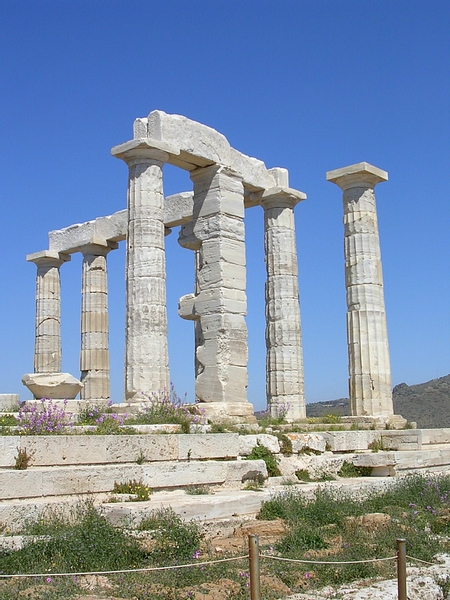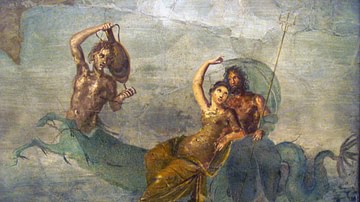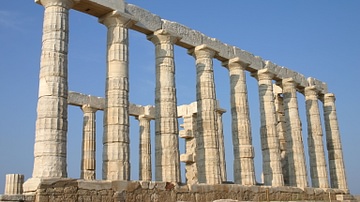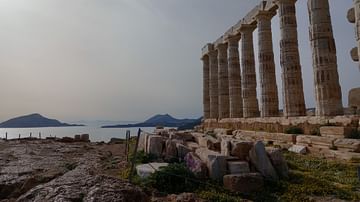
Sounion (or Sunium) was an important ancient Greek religious sanctuary sacred to the gods Poseidon and Athena. Spectacularly located on a promontory in southern Attica, the site is dominated by the temple of Poseidon perched on the cliff edge, seventy metres above the sea.
Sounion is the setting for several episodes in Greek mythology and is specifically mentioned as a place of religious significance in Homer's Odyssey. In some myths it is the spot where the Athenian king Aegeus threw himself into the sea in despair at having sighted the black sail of his son Theseus' ship returning from Crete and his battle with the Minotaur. Theseus had previously arranged to show a white sail to indicate his safe return but he forgot and so his father needlessly killed himself. The Aegean sea is named after the unfortunate king. It is also where Phrontis, one of Menelaus' captains, died on the return voyage from the Trojan War, killed by vengeful Apollo, who had supported the Trojans in the conflict.
The sanctuary came under the jurisdiction of the deme of Sounion which had its centre to the north in the Agrilesa Valley and gained its wealth from marble and silver. The site acquired its religious significance from the 7th century BCE and had one temple dedicated to Athena and another to Poseidon, god of the sea. The first stone temple to Athena was constructed in the 5th century BCE in the Ionic style and had an unusual asymmetrical form. The first stone temple to Poseidon was also constructed in the early 5th century BCE but was destroyed before completion by the Persians around 480 BCE and was replaced by a new marble temple.
The sacred area of the temple to Poseidon was entered through a monumental gate or propylaea which had a two Doric column façade creating three entrances, the central measuring 2.2 metres wide. Within the complex there were stoas on the west, south and north sides. The latter was the largest and its length measured 25 metres with 8 or 9 Doric columns on its façade and 6 interior columns, whilst the width of the stoa was 9 metres. This stoa was probably used by visitors to the sanctuary as a source of shelter from sun or rain.
The second and surviving temple of Poseidon was built upon the poros base of its predecessor using the locally pure white marble from Agrileza. The temple is peripteral, that is columns were on all sides - 6 on the façades and 13 on the long sides, each 6.12 metres tall. The temple is also amphiprostyle as the outer rows of columns are of the same order as the inner cella columns. The columns carry only 16 flutes rather than the usual 20, perhaps an attempt by the architect to reduce weathering in such an exposed site. Within the temple stood a statue of Poseidon (which has not survived) and the site's votive treasures would have been kept in the inner opisthodomos. The outer architrave (and probably pediments too) did not carry any architectural sculpture but the inner pronaos frieze did carry sculpture which depicted scenes from mythology such as a battle with centaurs.

Sounion was strategically important in controlling ships entering the Saronic gulf and, according to Thucydides, fortifications were constructed in 414 BCE by Athens (located just 67 km from the site) which were extended in the 3rd century BCE with the addition of ship-sheds. The area continued to develop and remain important in the Hellenistic period. Sounion also became involved in the Chremonidean War (266-229 BCE) and the subsequent Macedonian occupation under Antigonus. However, Athens regained control of the sanctuary when Aratus bribed the local commander Diogenes into giving it up after military action had previously failed. In the 2nd century BCE Sounion was the focus of a slave rebellion when it was occupied by over a thousand slaves from the nearby Lavrion silver mines. Following the mines closure shortly afterwards, Sounion began a steady decline and all but disappeared from Mediterranean affairs.
Archaeological finds from the site include two archaic colossal marble kouroi statues which date from around 600 BCE, fourteen sculpted panels from the temple of Poseidon, a fine relief tablet of a victorious athlete and a 7th century BCE lead kouros statue from the Temple of Athena.





